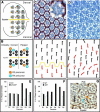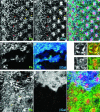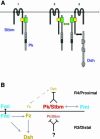Prickle and Strabismus form a functional complex to generate a correct axis during planar cell polarity signaling
- PMID: 12941693
- PMCID: PMC202366
- DOI: 10.1093/emboj/cdg424
Prickle and Strabismus form a functional complex to generate a correct axis during planar cell polarity signaling
Abstract
Frizzled (Fz) signaling regulates the establishment of planar cell polarity (PCP). The PCP genes prickle (pk) and strabismus (stbm) are thought to antagonize Fz signaling. We show that they act in the same cell, R4, adjacent to that in which the Fz/PCP pathway is required in the Drosophila eye. We demonstrate that Stbm and Pk interact physically and that Stbm recruits Pk to the cell membrane. Through this interaction, Pk affects Stbm membrane localization and can cause clustering of Stbm. Pk is also known to interact with Dsh and is thought to antagonize Dsh by affecting its membrane localization. Thus our data suggest that the Stbm/Pk complex modulates Fz/Dsh activity, resulting in a symmetry-breaking step during polarity signaling.
Figures







References
-
- Adler P.N. (2002) Planar signaling and morphogenesis in Drosophila. Dev. Cell, 2, 525–535. - PubMed
-
- Adler P.N. and Lee,H. (2001) Frizzled signaling and cell–cell interactions in planar polarity. Curr. Opin. Cell Biol., 13, 635–640. - PubMed
-
- Adler P.N., Charlton,J. and Liu,J. (1998) Mutations in the cadherin superfamily member gene dachsous cause a tissue polarity phenotype by altering frizzled signaling. Development, 125, 959–968. - PubMed
Publication types
MeSH terms
Substances
Grants and funding
LinkOut - more resources
Full Text Sources
Other Literature Sources
Molecular Biology Databases

